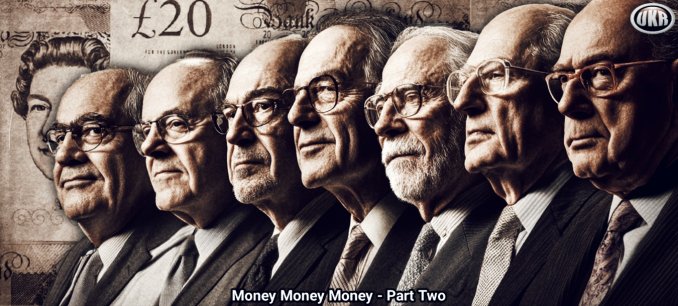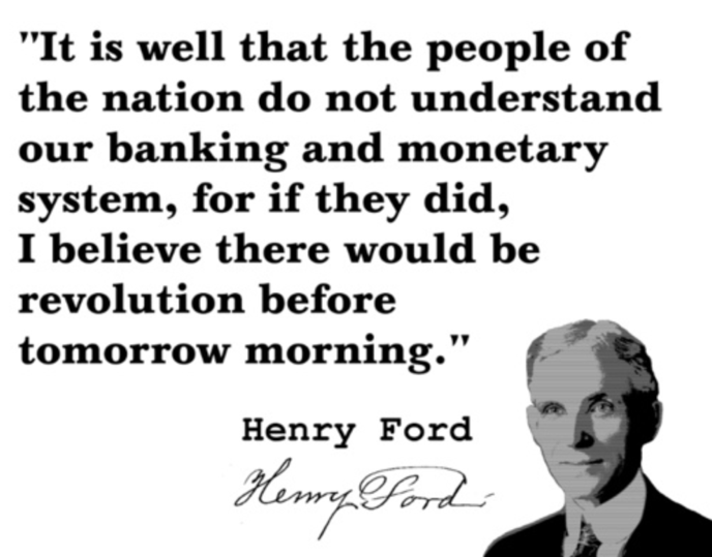
Continuing the Problem with Fiat Currency
IAIN HUNTER
In the previous essay on money, I opened with a brief tale of a ten-shilling note, the forerunner of today’s fifty pence coin, which I took as an example of how much our currency has been debauched since 1971. That year was the inflection point at which the Great Inflation really got going. US President Richard Nixon took the United States off the Gold Standard, and the American Dollar became a fiat currency. It spelt the end of the Bretton Woods system which had been in operation since the end of the Second World War. The Pound Sterling was delinked from the US Dollar the following year with its value henceforward determined by the international money markets. It has generally gone South ever since.
Coupled with the gross inflation of the last fifty odd years there have been relentless price rises within sectors of the economy which have proved catastrophic for the economic well-being of the general population. Britain was changed from a society which saved, repaired and made do into a society which consumed, threw away and bought anew through the mechanism of easy credit. We were urged not to wait but to ’buy it now’ on ‘easy terms’, first through the existing hire purchase arrangements then with the aid of credit cards and personal loans. We got desirable goods quickly and our standard of living rose. It was an illusion, a short-term gain, as our capacity to save and create our own individual private capital reduced. Who were the real beneficiaries? The bankers, of course.
The extension of easy credit had serious downsides, chief among them being the price of a home. At the start of 1971, the average house price in Britain was £4,500, a multiple of about four times the average income which a single-earner family could afford, especially given the tax regime at the time which was much more favourable towards marriage and the family. Today it is £272,750, nearly nine times the average income, within a tax system which punishes marriage and the family so that now it takes two full time average earners to buy a house. No wonder the average age of first-time buyers is approaching 40; No wonder people can barely afford to have children. We used to marry, have our first child and get on the housing ladder in our 20s. What happened?
Inflation is what happened, the hidden tax which is always and everywhere the result of deliberate policy and inherent within the global fiat currency systems. The money supply has grown and grown and grown. It is the enemy which makes it pointless to hold large deposits in a bank. Quite apart from the risk of the bank going bust, resulting in the loss of your savings, why do it when the value of your savings, which is the stored value of the work you have done (after tax), is eroded year on year despite the paltry interest credited to your account? It makes it more gainful to invest in the stock markets in which one invests directly or indirectly in the major companies – which are largely owned and controlled by the bankers. And be under no illusions, it is the central bankers who control the stock markets. Nonetheless, vast amounts of money have found their way into the stock markets either through direct stock and bond investments or through pension funds on both sides of the Atlantic. Thus, there have arisen financial behemoths such as BlackRock, Vanguard and Fidelity which do what they do with other people’s money, making their owners and executives billionaires in the process. And, dear reader, I have been invested in them from time to time, so my cards are face up on the table.
It wasn’t always this way.
During the nineteenth century, the golden age of Britain during which the middle classes arose, our ancestors lived in a time of sound money. Britain was on the gold standard from 1821 and over the course of the century the real value of money more than doubled as the prices of goods and services came down driven by the industrial revolution. Even if money in a bank, or under floorboards, earned little interest, it became twice as valuable in real terms as the day it was earned. The store of value of work done grew with time and over the century the prices of just about everything more than halved. People knew that the energy expended in their work was stored and preserved in their money and it would become more valuable with time. That is one serious incentive to save.
So, what can we do to free ourselves from the shackles of inflationary fiat currency and preserve the wealth we have accrued over our working lives whether we were employees, or self-employed, or entrepreneurs who employed others?
What most of us who are modestly successful have done is buy our homes. It has generally been a good investment, especially if we added to or improved them because the value added to the home would usually exceed the cost of the improvements. But the one great weakness of this is that the value depends on the market and the number of people in the market. It doesn’t take much, as those of us who can recall the 1990s will know, for there to be a major recession and market downturn resulting in severe financial distress for many home buyers who can neither afford to stay in their homes nor sell them at a price which repays their mortgages and leaves then with some capital. Home buyers are at the mercy of interest rates and credit supply. Increase the former and restrict the latter, as banks are able to do, and the result is Micawberish misery, and the banks take the property.
Art, jewellery, antiques and classic cars can be good investments, but luck is involved because the future value of them depends on human taste, foibles and the fact that one would be selling in a small market. Besides, they are generally regarded as luxury items. Once something goes out of fashion it becomes less valuable. Classic cars can become a liability because they have to be garaged and maintained, perhaps even re-built. They’d have to be driven as little as possible to preserve value. They’re really an expensive hobby.
That leaves us with the monetary metals, gold and silver and perhaps platinum as many podcasters having been pushing since 2020 in anticipation of an expected global financial crisis. The gold price has certainly gone up considerably, driven by the central banks which clearly know something, but silver is yet to really take off despite its many industrial uses.
It’s a good idea to have some gold among your savings and investment if you can but that means it has to be in a discrete safe in your house or a vault somewhere. It’s too valuable even in the smallest ingots and coins to be an everyday medium of exchange but there’s no denying that it’s a good store of value. At the very least, it is a store of the value of the land, labour and capital that went into its discovery and purification. All the gold in the world has existed since before the Earth was created; no more is being made. A consensus among the gold bugs seems to be that one should have up to 10% of one’s gross wealth in gold.
In the United Kingdom, the most tax efficient way of owning gold is in coins and if they are sovereigns or Britannias they are free of both Value Added Tax and Capital Gains Tax because they are considered to be currency. Sovereigns will be 22 carat gold because they have some copper in them to harden them for circulation. They will contain 7.31 grams of gold – about a quarter of an ounce – and cost around £750 each. That bears thinking about simply because one gold sovereign was originally one pound! Britannias, on the other hand, are 1 ounce of fine gold, priced at just over £3,000 each at present.
That deals with preserving some wealth but what about a practical medium of exchange and account as well as some fungibility? The current price of silver is around £35 per ounce and one ounce silver Britannias for investment are £41-£48 each. Silver alloy coins could be minted with a gram or so of silver in a £1 coin and 5 grams or so in a £5 coin. There could even be a £10 coin containing 10 grams. Why not? The way things are going a pint of beer will soon be £10. Coins of lesser value than £1 could be left as they are.
Could we return to the gold standard? I don’t think so because the gold reserves held by the Bank of England are just 310 tons. If you do the arithmetic with gold at £2,850 per ounce that is worth just £31.676 billion. Even using a 10% fractional reserve that would be £316.76 billion backing for a currency. That’s hardly enough when the GDP of the UK is currently £2.855 trillion with a National Debt at a similar figure and rising, not to mention the unfunded public sector pension liabilities which are estimated to be in the order of £6 trillion.
We bandy these large numbers around and many people have no conception of just how large they are. To illustrate the point, suppose it were decided to pay down £1 trillion of the National Debt and it were to be repaid at the rate of £1 per second. How long would that take? The answer is 32,000 years! At a more realistic rate of £1,000 per second it’s still going to take 32 years at over £31.5 billion per year. You can see the problem with our National Debt.
This, however, is just skating around the issue. The real problem is the central banks and their monopoly of debt-based money creation at interest. We need to understand that fiat currency is an instrument that the central bankers can use to wage a war of enslavement and deprivation against the people. However, in view of the threat of digital ID and Central Bank Digital Currency, we must ensure that we keep cash alive even if it is fiat cash. We need to understand too that 95% of the money supply is loans which never materialise in currency. They are created out of nothing and just pass from one bank ledger to another.
We need a complete overhaul of our monetary system. We should treat money creation as a public utility under democratic control, not under the control of private central bankers, and make sure its benefits are returned to the people. We could even usher in debt reform and use the ancient custom of jubilees to break the cycle of debt-enslavement.
How we might do that will be the subject of the third and final part of this series on money.

This article (Money Money Money – Part Two) was created and published by Iain Hunter and is republished here under “Fair Use”

••••
The Liberty Beacon Project is now expanding at a near exponential rate, and for this we are grateful and excited! But we must also be practical. For 7 years we have not asked for any donations, and have built this project with our own funds as we grew. We are now experiencing ever increasing growing pains due to the large number of websites and projects we represent. So we have just installed donation buttons on our websites and ask that you consider this when you visit them. Nothing is too small. We thank you for all your support and your considerations … (TLB)
••••
Comment Policy: As a privately owned web site, we reserve the right to remove comments that contain spam, advertising, vulgarity, threats of violence, racism, or personal/abusive attacks on other users. This also applies to trolling, the use of more than one alias, or just intentional mischief. Enforcement of this policy is at the discretion of this websites administrators. Repeat offenders may be blocked or permanently banned without prior warning.
••••
Disclaimer: TLB websites contain copyrighted material the use of which has not always been specifically authorized by the copyright owner. We are making such material available to our readers under the provisions of “fair use” in an effort to advance a better understanding of political, health, economic and social issues. The material on this site is distributed without profit to those who have expressed a prior interest in receiving it for research and educational purposes. If you wish to use copyrighted material for purposes other than “fair use” you must request permission from the copyright owner.
••••
Disclaimer: The information and opinions shared are for informational purposes only including, but not limited to, text, graphics, images and other material are not intended as medical advice or instruction. Nothing mentioned is intended to be a substitute for professional medical advice, diagnosis or treatment.
Disclaimer: The views and opinions expressed in this article are those of the author and do not necessarily reflect the official policy or position of The Liberty Beacon Project.






Leave a Reply